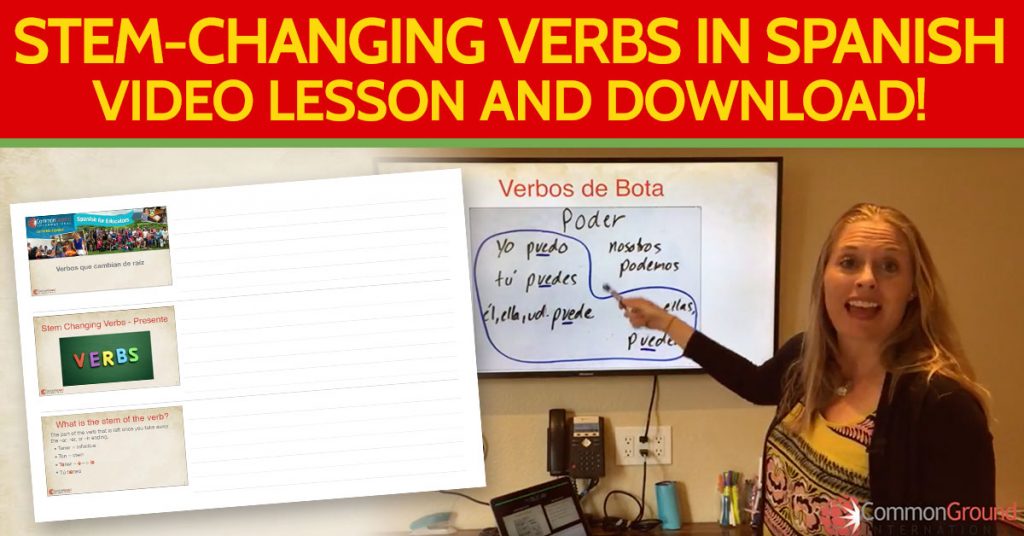This Spanish for Educators lesson focuses on understanding the stem-changing verbs in Spanish and start using them in the classroom: Verbos que cambian de raíz o verbos de bota.
Su reto profesional: memorizar y usar estos verbos que cambian de raíz para usarlos en las conversaciones en clase / Memorize these stem-changing verbs and start using them in your classroom!
Here is Spanish lesson all about Stem-changing Verbs in Spanish I taught to the Facebook group:
Subscribe to our YouTube Channel to see all of our lessons and get the latest videos right away!
What is the stem of the verb? / ¿Cuál es la raíz del verbo?
The stem is the part of the verb that is left once you take away the -AR, -ER or -IR endings.
Example:
- Escribir: -IR is the ending so Escrib is the stem of the verb.
But, what happens when the stem of the verb changes after taking away the ending? Here you can see it explained:
TENER (To Have)
- Tener: infinitivo
- Ten: stem
- Tener = e changes to ie
- Example: Tú tienes
- In Yo form, the verb is irregular: Yo tengo
In regular verbs, the stem doesn’t change no matter what ending you add on it when conjugate it (La raíz no cambia).
HABLAR (To Speak)
- Hablar: infinitivo
- Habl: stem
- Yo hablo, tú hablas, etc.
Stem-changing Verbs / Verbos que cambian la raíz
In present tense, there are three main types of changes:
- O changes to UE
- E changes to IE
- E changes to I
- And just one verb changes from U to UE (and this verb is important for you to learn!)
Repasemos la tabla de los verbos regulares / Regular Verbs Table
| Person | AR | ER | IR |
| Yo | O | O | O |
| Tú | AS | ES | ES |
| Él, Ella, Usted | A | E | E |
| Nosotros | AMOS | EMOS | IMOS |
| Ellos, Ellas, Ustedes | AN | EN | EN |
Ahora revisemos los verbos que cambian la raíz
O to UE Verbs
- Almorzar (To eat lunch) = almuerzo

- Contar (To count) = cuento
- Costar (To cost) = cuesto
- Devolver (To return) devuelvo
Note: In Spanish, the verb “Costar” also means to find something hard or difficult.
Example:
- Me cuesta hacer la tarea por las noches (I find it hard to do homework at evenings)
- Me cuesta entender matemáticas
 (Math is difficult for me)
(Math is difficult for me)
E to IE Verbs
- Acertar (To guess / get something right) = acierto
- Advertir (To warn) = advierto
- Comenzar (To commence / begin / start) = comienzo
- Empezar (To commence / begin / start) = empiezo
Note: The verbs “comenzar” and “empezar” are synonyms and you can use both of them in the same conversation without any problem. However, if you speak with someone from Spain, you’ll notice they prefer to use “empezar” when speaking and “comenzar” for writing. Nevertheless, In Latin America there is not any preference.
E to I Verbs
- Competir (To compete) = compito
- Corregir (To correct) = corrijo

- Decir (To say) = digo
- Medir (To measure): = mido
Some examples / Algunos ejemplos
Encontrar (To find)
| Yo encuentro | Nosotros encontramos |
| Tú encuentras | Vosotros encontráis |
| Él / Ella / Usted encuentra | Ellos / Ellas / Ustedes encuentran |
Entender (To understand)
| Yo entiendo | Nosotros entendemos |
| Tú entiendes | Vosotros entendéis |
| Él / Ella / Usted entiende | Ellos / Ellas / Ustedes entienden |
Decir (To say / tell)
Jugar (To play)
This is the only verb that has the change U to UE in present tense, so it’s important for you to memorize how to use it with your students.
Examples:
Verbos de Bota
You can also call these verbs, Verbos de Bota (boot verbs). Can you see the shape of a boot of the verbs that reflect the stem change?

Notice the stem change happens in those verbs located inside the boot, while the conjugation with “nosotros” (and “vosotros”) is outside the boot. This is a visual way to memorize these particular verb conjugations 😀
Classroom Uses / Usos en el aula
Verbo poder (To be able to)
- Teacher, ¿Puedo ir al baño? (Teacher, can I go to the restroom?)
- Pueden hacer otro ejercicio
 (You can do another exercise)
(You can do another exercise) - ¿Podemos ir al recreo? (Can we go to recess?)
Verbo sentir (To feel)
Otros verbos / Other Verbs
- ¿Cuánto cuesta el almuerzo? (How much does the lunch cost?)
- ¿Qué dicen ustedes? (What do you say?)
- Corrijo mis ejercicios de matemáticas
 (I’m correcting my Math exercises.)
(I’m correcting my Math exercises.)
Now it’s your turn! / Ahora es tu turno
Study all of this classroom vocabulary in Spanish with these flashcards!
Download the lesson notes and start creating your own sentences using this new vocabulary in Spanish and share them on the comments below or in our Facebook group to receive feedback from other Spanish learners






